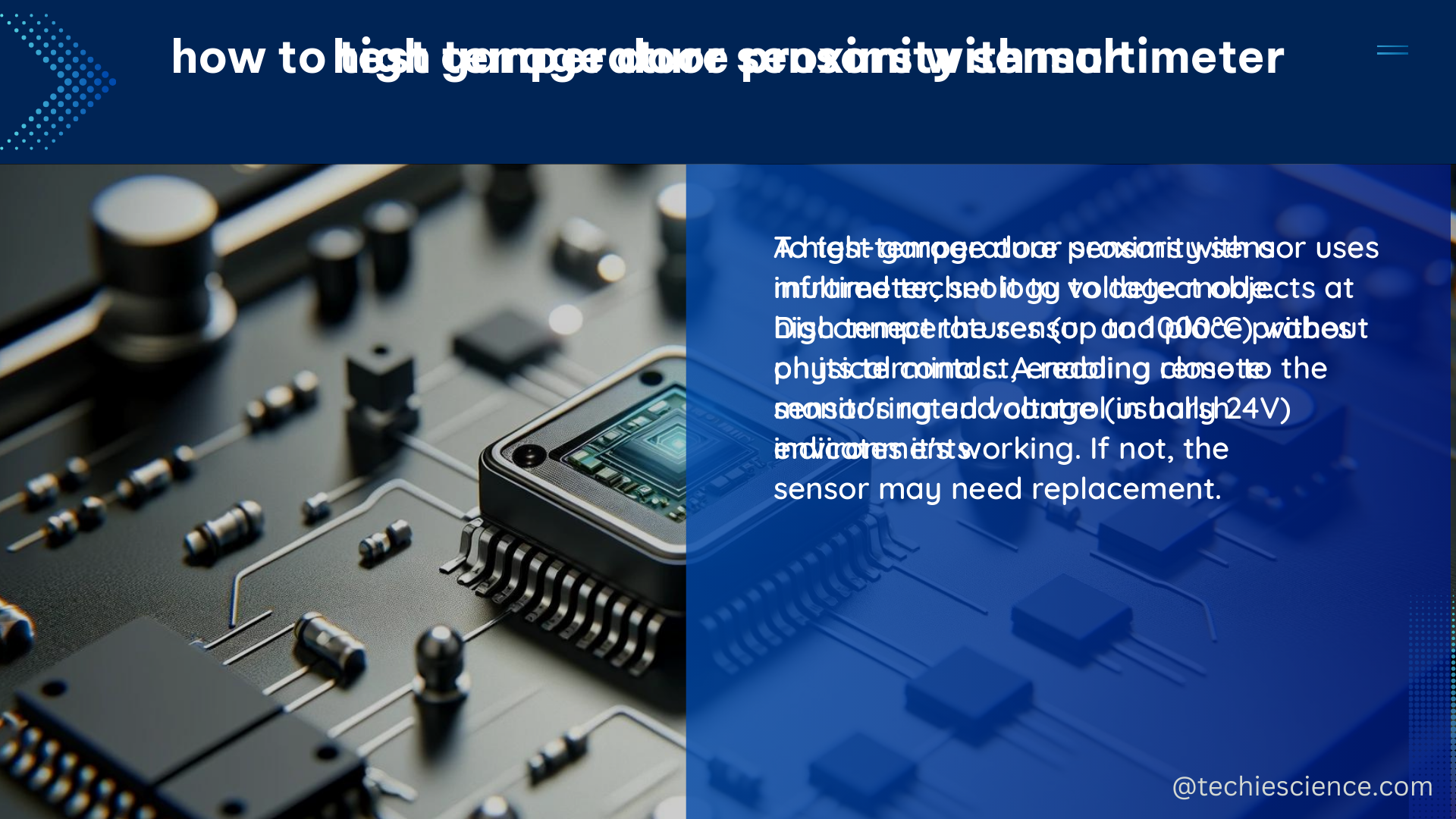High temperature proximity sensors are specialized devices designed to detect the presence or absence of objects in extreme temperature environments, typically above 200°C. These sensors are crucial in various industrial applications such as automotive, aerospace, and oil & gas industries where high temperature conditions are prevalent.
Operating Temperature Range
One of the key specifications of high temperature proximity sensors is their operating temperature range. For instance, the Honeywell HMC2011 High Temperature Proximity Sensor has an operating temperature range of -40°C to +250°C, while the Omega Engineering OSXL-HT Series can withstand temperatures up to 600°C. This wide temperature range ensures reliable and accurate sensing in harsh environments.
| Sensor Model | Operating Temperature Range |
|---|---|
| Honeywell HMC2011 | -40°C to +250°C |
| Omega Engineering OSXL-HT Series | -40°C to +600°C |
| Baumer FHDK 14 | -40°C to +300°C |
| Pepperl+Fuchs NBN40-L2-E2-V1 | -40°C to +120°C |
Response Time

Another critical specification is the sensor’s response time, which indicates how quickly the sensor can detect the presence or absence of an object. The TE Connectivity Limit Switch, for example, has a response time of less than 1 ms, while the Balluff BES 516-300-S4-C-PU-03 Inductive Proximity Sensor has a response time of 0.5 ms. This rapid response time is essential in applications where quick detection is crucial.
| Sensor Model | Response Time |
|---|---|
| TE Connectivity Limit Switch | < 1 ms |
| Balluff BES 516-300-S4-C-PU-03 | 0.5 ms |
| Turck NI4-M12-AP6X-H1141 | 1 ms |
| Sick IM18-08BPSZC0S Inductive Proximity Sensor | 0.8 ms |
Measurement Range
High temperature proximity sensors also have a measurement range, which indicates the distance within which the sensor can detect an object. The Baumer Ultrasonic Sensor, for instance, has a measurement range of up to 6000 mm, while the Pepperl+Fuchs NBN40-L2-E2-V1 Inductive Proximity Sensor has a detection range of up to 40 mm.
| Sensor Model | Measurement Range |
|---|---|
| Baumer Ultrasonic Sensor | Up to 6000 mm |
| Pepperl+Fuchs NBN40-L2-E2-V1 | Up to 40 mm |
| Turck NI4-M12-AP6X-H1141 | 2 mm to 4 mm |
| Sick IM18-08BPSZC0S | 2 mm to 8 mm |
Accuracy and Repeatability
The sensor’s accuracy is another crucial specification. Accuracy refers to how closely the sensor’s output corresponds to the actual value of the measured variable. For example, the IFM Efector Inductive Proximity Sensor has an accuracy of ±0.5% of the measurement range, while the Pepperl+Fuchs NBN40-L2-E2-V1 has an accuracy of ±1% of the full scale.
Lastly, high temperature proximity sensors have a repeatability specification, which indicates how consistently the sensor can measure the same object under the same conditions. The Pepperl+Fuchs NBN40-L2-E2-V1 Inductive Proximity Sensor, for instance, has a repeatability of ±0.5% of the measurement range, and the Sick IM18-08BPSZC0S has a repeatability of ±0.1 mm.
| Sensor Model | Accuracy | Repeatability |
|---|---|---|
| IFM Efector Inductive Proximity Sensor | ±0.5% of measurement range | – |
| Pepperl+Fuchs NBN40-L2-E2-V1 | ±1% of full scale | ±0.5% of measurement range |
| Sick IM18-08BPSZC0S | – | ±0.1 mm |
| Turck NI4-M12-AP6X-H1141 | ±1% of full scale | ±0.2% of full scale |
DIY High Temperature Proximity Sensors
In terms of DIY high temperature proximity sensors, one can consider using thermocouples or infrared sensors. Thermocouples are relatively simple devices that consist of two dissimilar metal wires joined at one end. When the junction of the two metals is heated, it generates a voltage proportional to the temperature. This voltage can be measured and used to detect the presence or absence of an object.
Infrared sensors, on the other hand, detect the infrared radiation emitted by an object. These sensors can be used to detect the presence or absence of an object in high temperature environments. However, they require more complex electronics to interpret the sensor’s output.
To build a DIY high temperature proximity sensor, one would need to select a suitable sensor (thermocouple or infrared), design a circuit to interpret the sensor’s output, and program a microcontroller to control the sensor and output the results. The circuit design and microcontroller programming will depend on the specific sensor and application requirements.
Conclusion
High temperature proximity sensors are critical components in various industrial applications. When selecting a high temperature proximity sensor, it is essential to consider the sensor’s operating temperature range, response time, measurement range, accuracy, and repeatability. For DIY high temperature proximity sensors, thermocouples or infrared sensors can be used, and a suitable circuit and microcontroller can be designed to interpret the sensor’s output.
References
- Honeywell HMC2011 High Temperature Proximity Sensor datasheet: https://www.honeywell.com/us/en/product/hmc2011-high-temperature-proximity-sensor
- TE Connectivity Limit Switch datasheet: https://www.te.com/commerce/DocumentDelivery/DDEController?Action=srchrtrv&DocNm=1-2358051-1&DocType=DS&DocLang=EN
- Baumer Ultrasonic Sensor datasheet: https://www.baumer.com/en/products/sensors/ultrasonic-sensors/series/ust-30-series/
- IFM Efector Inductive Proximity Sensor datasheet: https://www.ifm.com/us/en/products/proximity-sensors/inductive/proximity-sensors-with-standard-flange/
- Pepperl+Fuchs Inductive Proximity Sensor datasheet: https://www.pepperl-fuchs.com/global/en/products/sensors-identification/inductive-proximity-sensors/standard-inductive-proximity-sensors/
- Omega Engineering OSXL-HT Series datasheet: https://www.omega.com/en-us/sensors-and-sensing-equipment/temperature/thermocouples/osxl-ht-series/p/OSXL-HT-Series
- Balluff BES 516-300-S4-C-PU-03 datasheet: https://www.balluff.com/local/us/products/sensors/inductive-sensors/bes-516-300-s4-c-pu-03/
- Turck NI4-M12-AP6X-H1141 datasheet: https://www.turck.com/en/products/detail/NI4-M12-AP6X-H1141/100000421
- Sick IM18-08BPSZC0S datasheet: https://www.sick.com/us/en/proximity-sensors/inductive-proximity-sensors/im18/im18-08bpszc0s/p/p103524

The lambdageeks.com Core SME Team is a group of experienced subject matter experts from diverse scientific and technical fields including Physics, Chemistry, Technology,Electronics & Electrical Engineering, Automotive, Mechanical Engineering. Our team collaborates to create high-quality, well-researched articles on a wide range of science and technology topics for the lambdageeks.com website.
All Our Senior SME are having more than 7 Years of experience in the respective fields . They are either Working Industry Professionals or assocaited With different Universities. Refer Our Authors Page to get to know About our Core SMEs.